The Hemingray-Brooke Dispute Revisited
by Bob Stahr
Reprinted from "Crown Jewels of the Wire", February 1996, page 28
The time is July 3, 1873.
The place; the U.S. Patent Office.
The patent of Louis Cauvet has now been around for nearly eight years. Most
telegraph companies now see the advantage of using threaded insulators and are
probably ordering them for new construction or for upgrading existing lines. Any
glass company that is involved with Insulator manufacture is trying to produce
threaded insulators. We will be hearing a decision from the Commissioner of
Patents about other insulator threading patents. This is actually an appeal to
an earlier decision by the Board of Examiner-In-Chief.
Before the hearing, first
some history. If there is a patent application pending in the patent office at
the same time another similar patent application is submitted; an
"interference" is supposed to be declared between them. The Examiner
then decides which patent is given priority based upon who was first to invent
and tried to manufacture their idea.
In this case there were apparently three applications in the office at the
same time belonging to Homer Brooke, Robert Hemingray and James M. Brookfield.
By some mistake, Homer Brooke was granted his patent under a different class,
without an interference being declared between his and the applications of
Hemingray and Brookfield. Brookfield has admitted that Robert Hemingray and
Homer Brooke have both preceded him in their inventions. So the main dispute is
between Hemingray and Brooke.
The record of the hearing from the Official Gazette follows:
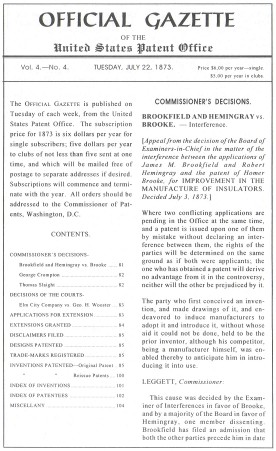
Medium Image (132 Kb)
Large Image (273 Kb)
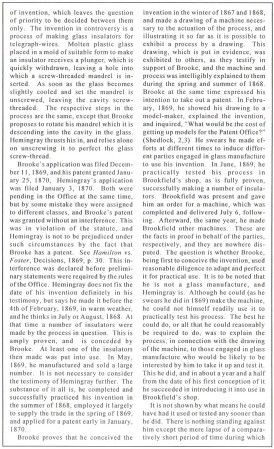
Medium Image (195 Kb)
Large Image (393 Kb)
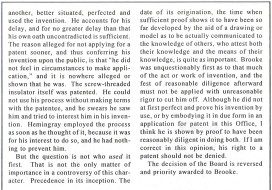
Medium Image (86 Kb)
Large Image (173 Kb)
With this testimony, we now know that Hemingray produced threaded insulators
around August of 1868. He later made a "great number" in May of 1869.
He applied for a patent January 3, 1870; which wasn't granted until December 19,
1871. (See following page for patent drawing.) This leaves a total gap of over
three years in which he could produce unembossed threaded insulators. I would
say those first ones were most likely the unembossed CD 127.4 insulators. The
CD 127.4 also appears in the patent drawing for the December 19, 1871 threading
process (applied for in 1870). These were probably Hemingray's version of the CD
127 style Western Union pattern made by Brookfield and others.
There is a chance
that Hemingray also produced the unembossed CD 131.4 during this time. I'm not
sure which style came first. The CD 732.2, which is a threadless twin to the CD
131.4, appears in the patent drawing for the Floyd pinhole. This patent was
granted in 1867; a full year before Hemingray produced his first threaded
insulators. Did Hemingray already make the CD 732.2 before Floyd used it in his
drawing; or did Hemingray make the CD 732.2 to Floyd's design? I have not heard
of a CD 732.2 that does not have a Floyd style pinhole. If anyone knows of one, that will probably clear up the
mystery. (The Floyd patent drawing is pictured on the following page.)
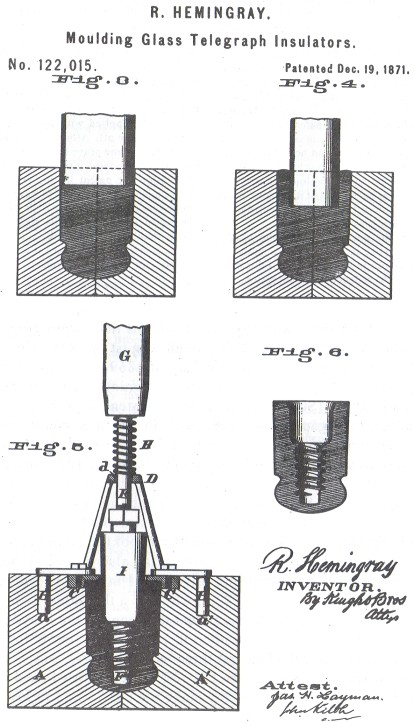
Large Image (195 Kb)
The Floyd
style pinhole is also known on the CD 732.2 with the December 19, 1871 patent
date (see CJ, June 1993). This piece was obviously made after the 1871 patent,
Hemingray could have used their unembossed CD 732.2 Floyd molds to make un
embossed CD 131.4 's, using a threaded mandrel. They then could have engraved
the molds with the Dec. 19, 1871 patent date and received an order for more
Floyd's. Thus an insulator with the 1871 date made to an 1867 patent.
Homer Brooke, on the other hand, conceived of his threading process during the winter
of 1867 and 1868; probably 6-8 months before Hemingray actually made his own
insulators. Brooke made a drawing of the invention when he thought of it, then
tried to sell it. In February of 1869, he inquired about building a model for
the patent office. In June of 1869 he tested it at Brookfield's shop after which
Brookfield ordered a machine. Brooke then filed a patent application on December
11, 1869.
The Examiner of Interferences in the first hearing felt that Brooke
had conceived of his invention first and should get priority. The Board of
Examiners-in-Chief felt that Hemingray was the first to produce items under his
invention, so he should get priority. This appeal was objecting to the Board
awarding priority to Hemingray. Although Hemingray was first to employ his
invention in threading insulators; Brooke was first in conceiving it. The
Commissioner decided to reverse the Board's decision and award priority to
Brooke.
The outcome of this decision had a large impact on insulator production.
Homer Brooke was able to sell rights to his patent of January 25, 1870, which
appears on 14 different styles of insulators made by both Brookfield and other
manufacturers. Hemingray was also able to keep rights to his patent although he
wasn't able to claim his patent came before Brooke's. Both Hemingray and Brooke
continued their involvement with glass production and become legends in glass
manufacturing history.
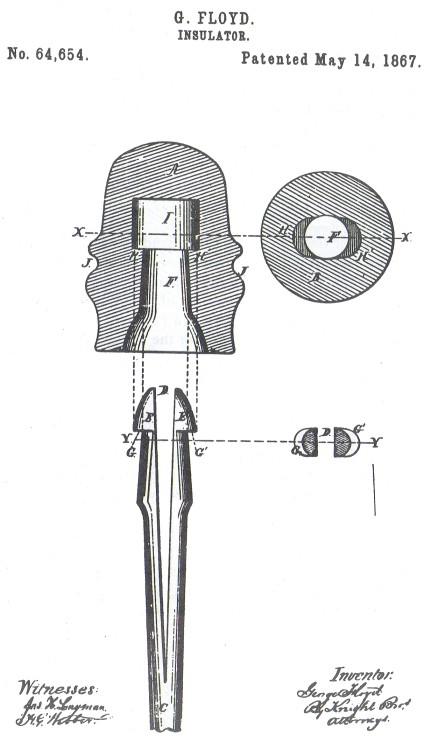
Large Image (130 Kb)
| 